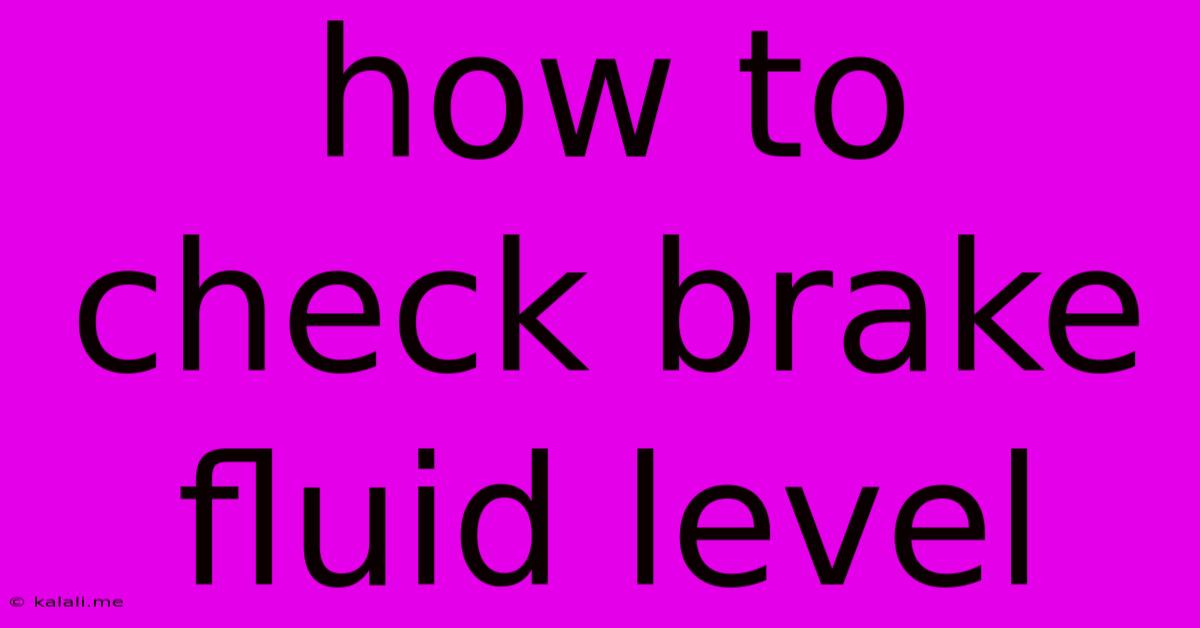How To Check Brake Fluid Level
Kalali
May 30, 2025 · 3 min read

Table of Contents
How to Check Your Brake Fluid Level: A Step-by-Step Guide
Meta Description: Learn how to safely and effectively check your brake fluid level. This guide provides a step-by-step process, safety tips, and explains what low brake fluid indicates. Avoid dangerous driving situations by understanding your vehicle's braking system.
Maintaining your car's braking system is crucial for safe driving. A critical part of this maintenance is regularly checking your brake fluid level. Low brake fluid can indicate a serious problem, potentially leading to brake failure. This article will guide you through the process of checking your brake fluid level safely and accurately.
Locating the Brake Fluid Reservoir
The first step is finding your brake fluid reservoir. This is usually a small, cylindrical container, often made of plastic, with a cap marked with a brake system symbol (often a circle with an exclamation point inside). Common locations include:
- Under the hood: This is the most frequent location. Check near the master cylinder, often towards the front of the engine compartment.
- In the engine compartment: Look for a clearly labeled reservoir. The labeling might directly say "brake fluid" or use the brake system symbol.
Consult your vehicle's owner's manual if you're having trouble locating it. The manual will provide specific diagrams and locations for your car model.
Checking the Brake Fluid Level
Once you've located the reservoir, follow these steps:
- Park your vehicle on a level surface: Ensure your car is securely parked and the engine is off.
- Locate the reservoir cap: Carefully remove the cap. You may need a rag to wipe away any dirt or debris before opening. Brake fluid is corrosive, so avoid getting it on your skin or painted surfaces.
- Check the fluid level: Most reservoirs have minimum and maximum markings on the side. The fluid level should be somewhere between these lines. If the level is low, near or below the minimum mark, it's time to address the issue.
- Inspect the fluid's condition: Brake fluid should be clear or light amber. Dark, murky fluid indicates it needs to be flushed and replaced. This should be done by a qualified mechanic.
What Low Brake Fluid Indicates
Low brake fluid level doesn't necessarily mean you have a leak immediately. However, it's a warning sign that warrants attention. Possible causes include:
- Brake pad wear: As your brake pads wear down, more fluid is needed to maintain pressure. This is a normal part of brake pad wear and tear.
- Brake fluid leaks: A leak in any part of the braking system will cause a drop in fluid level. This is a serious issue requiring immediate professional attention.
- Brake system malfunctions: Other internal components of your braking system might be damaged or malfunctioning.
Important Note: Never top off brake fluid with just any fluid. Always use the correct type of brake fluid specified in your owner's manual. Using the wrong fluid can damage your braking system.
When to Seek Professional Help
If you notice low brake fluid, especially if the fluid level is dropping quickly or accompanied by other symptoms like spongy brakes, unusual noises, or a pulling sensation, seek professional help immediately. Do not drive your car until the issue is diagnosed and repaired. Your safety and the safety of others depends on properly functioning brakes. Ignoring low brake fluid can lead to dangerous driving situations and brake failure.
This guide provides a basic understanding of how to check your brake fluid level. Remember, regular maintenance is key to safe driving. Consult your owner's manual for specific recommendations and always prioritize safety.
Latest Posts
Latest Posts
-
How To Change Back From Text Message To Imessage
Jun 01, 2025
-
How To Wire Outlet Switch Combo
Jun 01, 2025
-
Dnd Is 5 Feet Away Mean Touching
Jun 01, 2025
-
Weird Symbole Genertaed By Password Generator
Jun 01, 2025
-
Skyrim Shroud Hearth Barrow Pillar Puzzle
Jun 01, 2025
Related Post
Thank you for visiting our website which covers about How To Check Brake Fluid Level . We hope the information provided has been useful to you. Feel free to contact us if you have any questions or need further assistance. See you next time and don't miss to bookmark.